CMIP5 Projected Changes in the Annual Cycle of Indian Monsoon Rainfall
Abstract
:1. Introduction
2. Data and Methods
2.1. Data
2.2. Methods
- (i)
- (ii)
- (iii)
- Centroid [17]: This is an integral measure of the timing of the wet season and is related to the time of the year around which most of the annual rainfall is distributed. An index of the timing is directly derived from the Equation (1). Moreover, the centroid is defined in circular statistics as argument of the complex number zk, where k represents year (i imaginary unit).where p is the monthly precipitation in mm.
3. Results and Discussion
3.1. Observations of the 20th Century (1871–2005)
3.2. Simulation of Models.
3.3. Selecting the Best Model
3.3.1. On the Basis of MRPM Count
3.3.2. On the Basis of Average Intensity
3.3.3. On the Basis of Spatial Patterns
3.4. Best Model Predictions (2006–2100)
4. Conclusions
Acknowledgments
Author Contributions
Conflicts of Interest
References
- Jena, P.; Azad, S.; Rajeevan, M. Statistical selection of the optimum models in the CMIP5 dataset for climate change projections of Indian monsoon rainfall. Climate 2015, 3, 858–875. [Google Scholar] [CrossRef]
- Fisher, E.M.; Knutti, R. Anthropogenic contribution to global occurrence of heavy-precipitation and high-temp extremes. Nat. Clim. Chang. 2015, 5, 560–564. [Google Scholar] [CrossRef]
- Azad, S.; Rajeevan, M. Possible shift in the ENSO-Indian monsoon rainfall relationship under future global warming. Nat. Sci. Rep. 2016, 6. [Google Scholar] [CrossRef]
- Ashok, K.; Guam, Z.; Yamagata, T. Impact of the Indian Ocean dipole on the relationship between the Indian monsoon rainfall and ENSO. Geogr. Res. Lett. 2001, 28, 4499–4502. [Google Scholar] [CrossRef]
- Menon, A.; Levermann, A.; Schewe, J.; Lehmann, J.; Frieler, K. Consistent increase in Indian monsoon rainfall and its variability across CMIP-5 models. Earth Syst. Dyn. 2013, 4, 287–300. [Google Scholar] [CrossRef]
- Kumar, K.K. Impact of Climate Change on India’s Monsoonal Climate and Development of High Resolution Climate Change Scenarios for India; Indian Institute of Tropical Meteorology: Pune, India, 2009. [Google Scholar]
- Kumar, K.R.; Sahai, A.K.; Kumar, K.K.; Patwardhan, S.K.; Mishra, P.K.; Revadekar, J.V.; Kamala, K.; Pant, G.B. High-resolution climate change scenarios for India for the 21st century. Curr. Sci. 2006, 90, 334–345. [Google Scholar]
- Sharmila, S.; Joseph, S.; Sahai, A.K.; Abhilash, S.; Chattopadhyay, R. Future projection of Indian summer monsoon variability under climate change scenario: An assessment from CMIP5 climate models. Glob. Planet. Chang. 2015, 124, 62–78. [Google Scholar] [CrossRef]
- Duncan, J.M.A.; Dash, J.; Atkinson, P.M. Analysing temporal trends in the Indian summer monsoon and its variability at a fine spatial resolution. Clim. Chang. 2013, 117, 119–131. [Google Scholar] [CrossRef]
- Harrison, M. The development of seasonal and inter-annual climate forecasting. Clim. Chang. 2005, 70, 201–220. [Google Scholar] [CrossRef]
- Rajendran, K.; Sajani, S.; Jayasankar, C.B.; Kitoh, A. How dependent is climate change projection of Indian summer monsoon rainfall and extreme events on model resolution? Curr. Sci. 2013, 104, 1409–1418. [Google Scholar]
- Revadekar, J.V.; Patwardhan, S.K.; Kumar, K.R. Characteristic features of precipitation extremes over India in the warming scenarios. Adv. Meteorol. 2011, 28, 4499–4502. [Google Scholar] [CrossRef]
- Goswami, B.N.; Venugopal, V.; Sengupta, D.; Madhusoodanan, M.S.; Xavier, P.K. Increasing trend of extreme rain events over India in a warming environment. Science 2006, 314, 1442–1445. [Google Scholar] [CrossRef] [PubMed]
- Rajeevan, M.; Bhate, J.; Jaswal, A.K. Analysis of variability and trends of extreme rainfall events over India using 104 years of gridded daily rainfall data. Geophys. Res. Lett. 2008, 35. [Google Scholar] [CrossRef]
- Kulkarni, A.; Kripalani, R.H.; Sabde, S.S. Examining Indian Monsoon Variability in Coupled Climate Model Simulations and Projections; Research Report No. RR-125; Indian Institute of Tropical Meteorology: Pune, India, 2010. [Google Scholar]
- Sathiyamoorthy, V.; Joshi, P.C. Impact of increased CO2 on rainfall over Indian monsoon region in IPCC-AR4 CGCM simulations. In Proceedings of the ISPRS Ahmedabad 2009 Workshop: Impact of Climate Change on Agriculture, Ahmedabad, India, 17–18 December 2010.
- Seth, A.; Rauscher, S.A.; Biasutti, M.; Giannini, A.; Camargo, S.J.; Rojas, M. CMIP5 projected changes in the annual cycle of precipitation in monsoon regions. J. Clim. 2013, 26, 7328–7351. [Google Scholar] [CrossRef]
- Pascale, S.; Lucarini, V.; Feng, X.; Porporato, A.; Hasson, S. Projected changes of rainfall seasonality and dry spells in a high concentration pathway 21st century scenario. Clim. Dyn. 2015. [Google Scholar] [CrossRef]
- Lin, H.; Wang, B. The time-space structure of the Asian-Pacific summer monsoon: A fast annual cycle view. J. Clim. 2002, 15, 2001–2019. [Google Scholar] [CrossRef]
- Feng, X.; Porporato, I.; Rodriguez-Iturbe, I. Changes in rainfall seasonality in the tropics. Nat. Clim. Chang. 2013, 3, 811–815. [Google Scholar] [CrossRef]
- Parthasarathy, B.; Munot, A.A.; Kothawale, D.R. Monthly and Seasonal Rainfall Series for All-India Homogeneous Regions and Meteorological Subdivisions: 1871–1994; Indian Institute of Tropical Meteorology: Pune, India, 1995. [Google Scholar]
- Taylor, K.E.; Stouffer, R.J.; Meehl, G.A. An Overview of CMIP5 and the experiment design. Bull. Am. Meteorol. Soc. 2012, 93, 485–498. [Google Scholar] [CrossRef]
- Sperber, K.R.; Annamalai, H.; Kang, I.S.; Kitoh, A.; Moise, A.; Turner, A.; Wang, B.; Zhou, T. The Asian summer monsoon: An intercomparison of CMIP5 vs. CMIP3 simulations of the late 20th century. Clim. Dyn. 2013, 41, 2711–2744. [Google Scholar] [CrossRef]
- Pai, D.S.; Rajeevan, M. Indian summer monsoon onset: Variability and prediction. J. Earth Syst. Sci. 2009, 118, 123–135. [Google Scholar] [CrossRef]
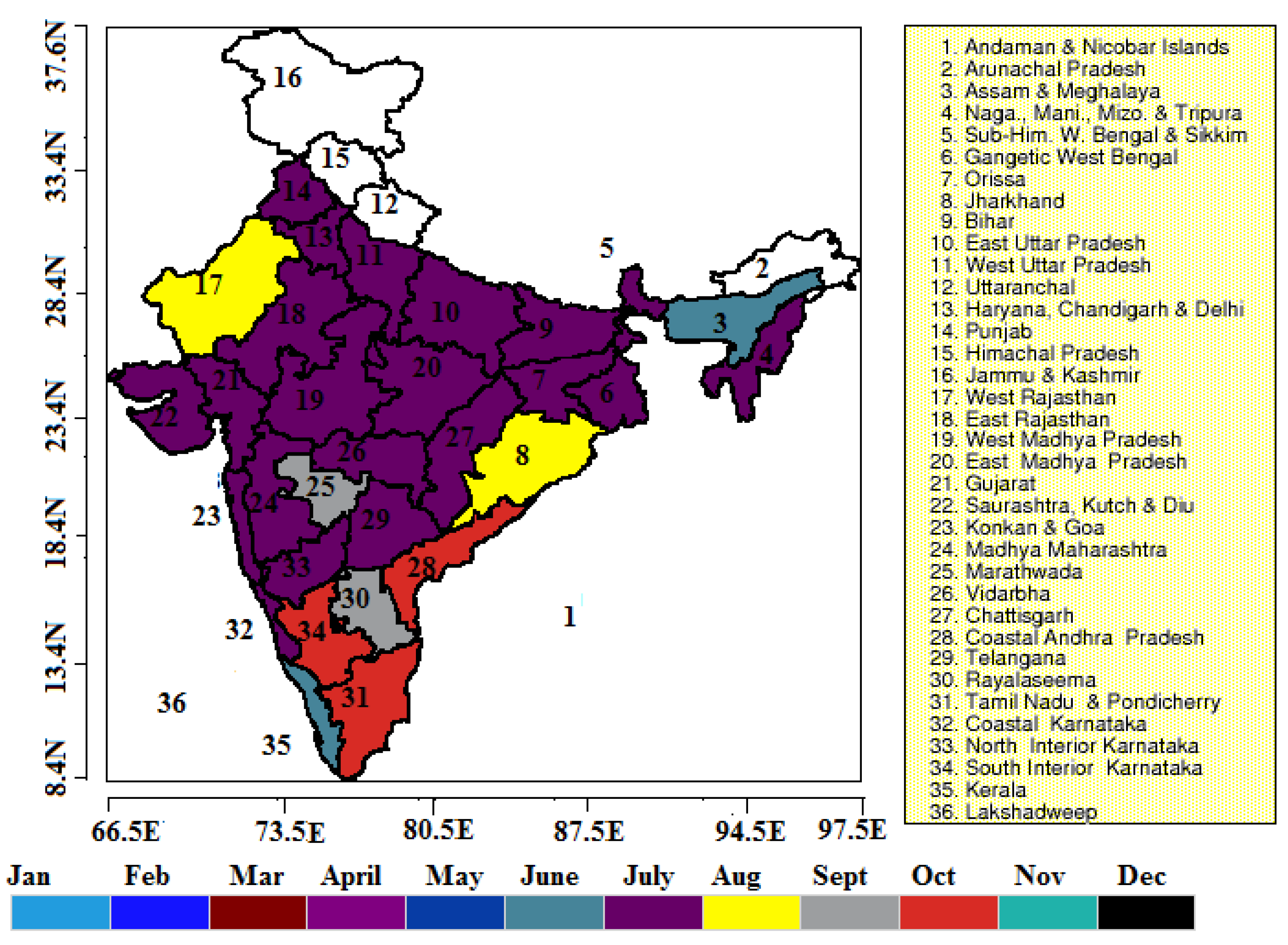
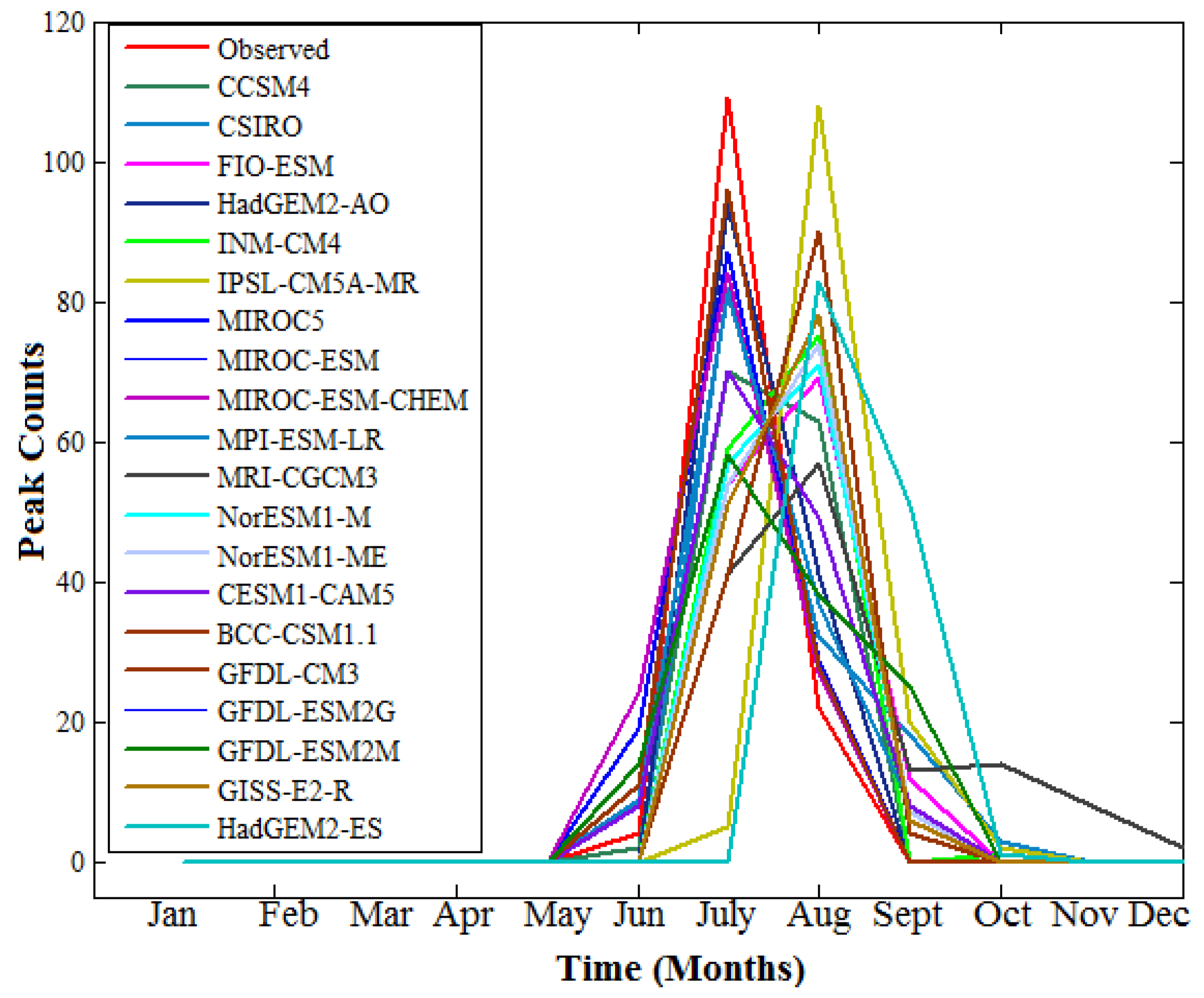
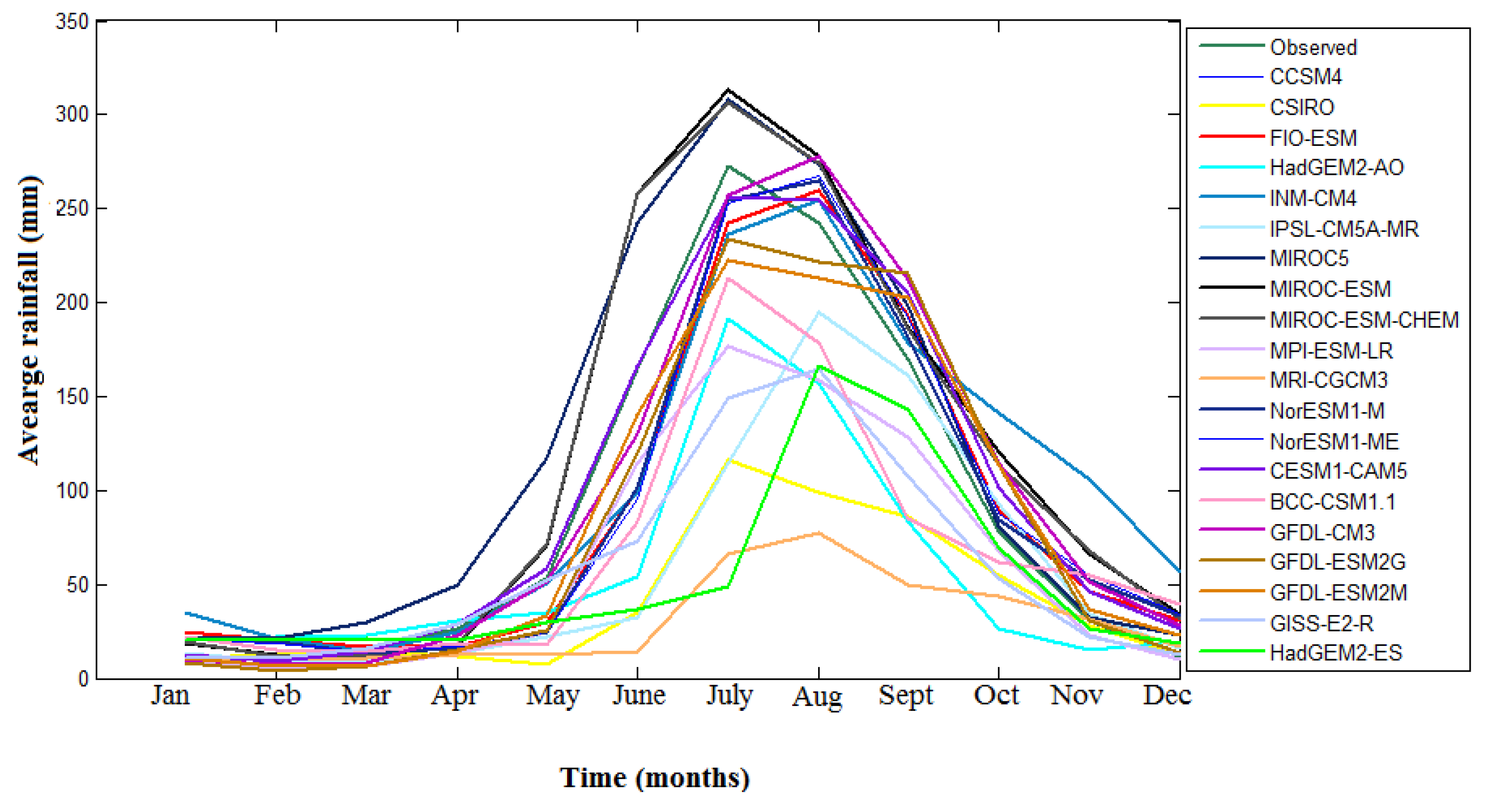
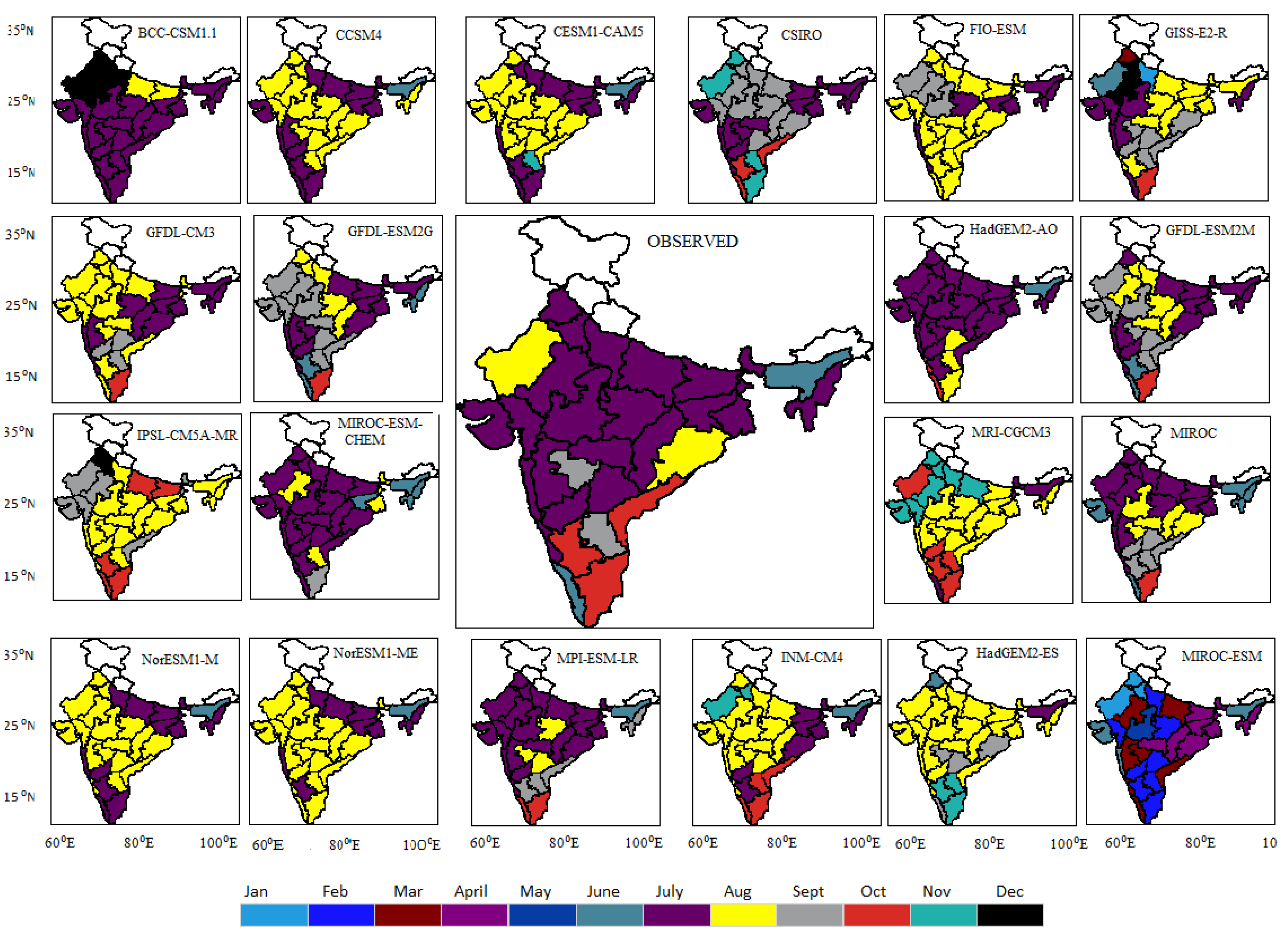
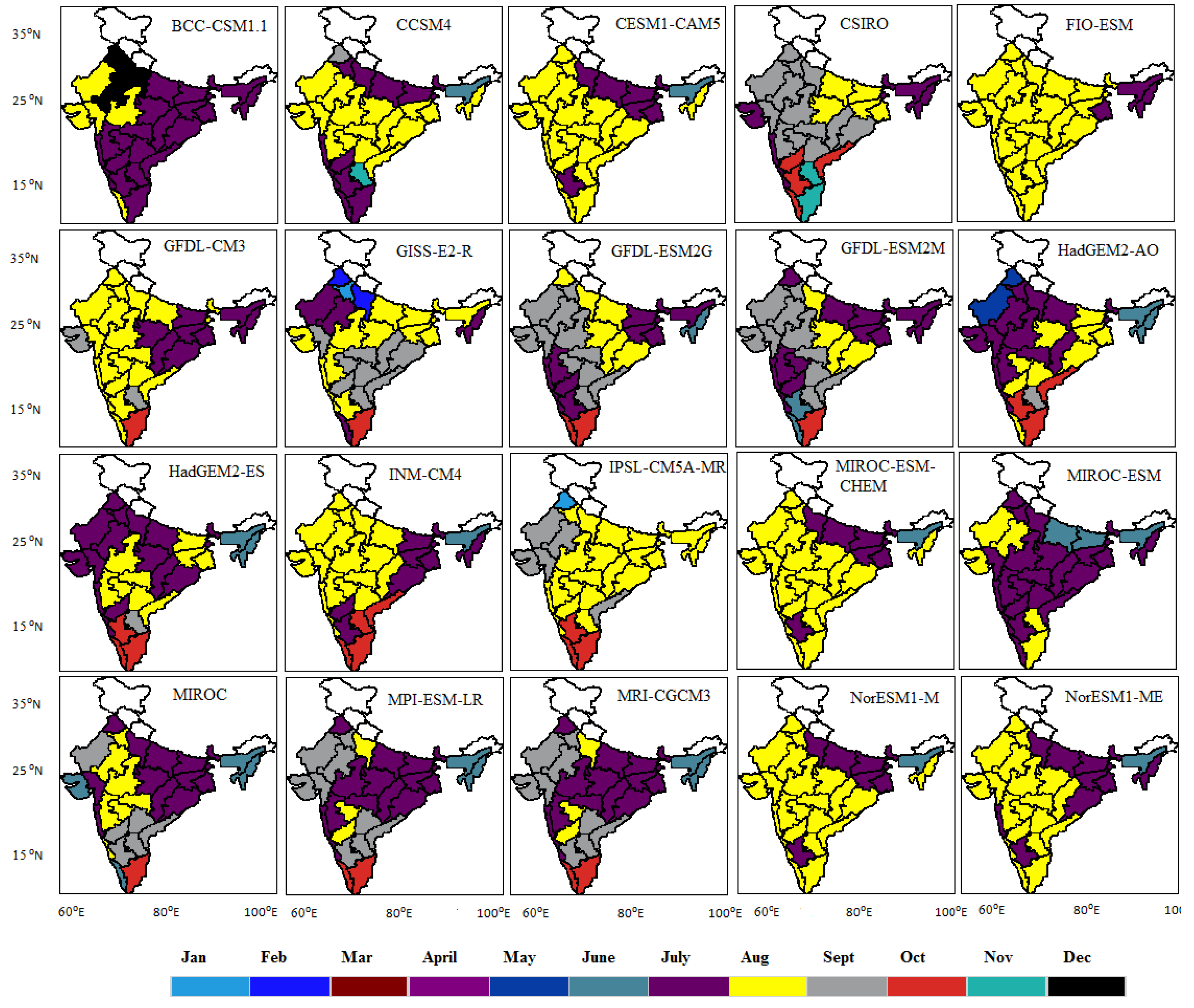
| S.no | Model (Long° × Lat°) | Modeling Centre (Group) |
|---|---|---|
| 1. | CCSM4 (1.25 × 0.9424) | National Center for Atmospheric Research, U.S.A (NOAA) |
| 2. | CSIRO-Mk3.6.0 (1.8750 × 1.8497) | Commonwealth Scientific & Industrial Research Organization in collaboration with Queensland Climate Change Center of Excellence |
| 3. | FIO-ESM (2.815 × 2.7673) | The First Institute of Oceanography, SOA, China |
| 4. | HadGEM2-AO (1.8750 × 1.25) | UKMO (United Kingdom Meteorological Office)Hadley Centre. |
| 5. | INM-CM4 (2 × 1.50) | Institute for Numerical Mathematics, Russia |
| 6. | IPSL-CM5A-MR (2.5 × 1.2676) | Institute Pierre-Simon Laplace, France |
| 7. | MIROC5 (1.4063 × 1.389) | Japan Agency for Marine-Earth Science and Technology, Atmosphere and Ocean Research Institute, and National Institute for Environmental Studies, Japan |
| 8. | MIROC-ESM (2.8125 × 2.7673) | Japan Agency for Marine-Earth Science and Technology, Atmosphere and Ocean Research Institute, and National Institute for Environmental Studies, Japan |
| 9. | MIROC-ESM-CHEM (2.8125 × 2.7673) | Japan Agency for Marine-Earth Science and Technology, Atmosphere and Ocean Research Institute, and National Institute for Environmental Studies, Japan |
| 10. | MPI-ESM-LR (1.25 × 0.9424) | Max Planck Institute for Meteorology, Germany |
| 11. | MRI-CGCM3 (1.125 × 1.1121) | Meteorological Research Institute, Japan |
| 12. | NorESM1-M (2.5 × 1.8947) | Norwegian Climate Centre, Norway |
| 13. | NorESM1-ME (2.5 × 1.8947) | Norwegian Climate Centre, Norway |
| 14. | CESM1-CAM5 (1.25 × 0.9424) | Community Earth System Model Contributors, NCAR (National Centre of Atomsperic Research) USA |
| 15. | BCC-CSM-1.1 (2.8125 × 2.7673) | Beijing Climate Center, China Meteorological Administration |
| 16. | GFDL-CM3 (2.5 × 2) | NOAA Geophysical Fluid Dynamics Laboratory |
| 17. | GFDL-ESM2G (2.5 × 1.5169) | NOAA Geophysical Fluid Dynamics Laboratory |
| 18. | GFDL-ESM2M (2.5 × 1.5169) | NOAA Geophysical Fluid Dynamics Laboratory |
| 19. | GISS-E2-R (2.5 × 2) | NASA Goddard Institute for Space Studies |
| 20. | HadGEM2-ES (1.8750 × 1.25) | Met Office Hadley Centre |
| Models | Historical (Peak Month) | Projection (Peak Month) |
|---|---|---|
| CCSM4 | July | July |
| CSIRO | July | August |
| FIO-ESM | August | August |
| HadGEM2-AO | July | July |
| INM-CM4 | August | August |
| IPSL-CM5A-MR | July | August |
| MIROC5 | July | July |
| MIROC-ESM- | July | July |
| MIROC-ESM-CHEM | July | July |
| MPI-ESM-LR | August | July |
| MRI-CGCM3 | August | August |
| NorESM1-M | August | August |
| NorESM1-ME | August | July |
| CESM1-CAM5 | July | August |
| BCC-CSM1.1 | July | July |
| GFDL-CM3 | August | August |
| GFDL-ESM2G | July | July |
| GFDL-ESM2M | July | July |
| GISS-E2-R | August | August |
| HadGEM2-ES | August | July |
© 2016 by the authors; licensee MDPI, Basel, Switzerland. This article is an open access article distributed under the terms and conditions of the Creative Commons by Attribution (CC-BY) license (http://creativecommons.org/licenses/by/4.0/).
Share and Cite
Jena, P.; Azad, S.; Rajeevan, M.N. CMIP5 Projected Changes in the Annual Cycle of Indian Monsoon Rainfall. Climate 2016, 4, 14. https://doi.org/10.3390/cli4010014
Jena P, Azad S, Rajeevan MN. CMIP5 Projected Changes in the Annual Cycle of Indian Monsoon Rainfall. Climate. 2016; 4(1):14. https://doi.org/10.3390/cli4010014
Chicago/Turabian StyleJena, Pravat, Sarita Azad, and Madhavan Nair Rajeevan. 2016. "CMIP5 Projected Changes in the Annual Cycle of Indian Monsoon Rainfall" Climate 4, no. 1: 14. https://doi.org/10.3390/cli4010014
APA StyleJena, P., Azad, S., & Rajeevan, M. N. (2016). CMIP5 Projected Changes in the Annual Cycle of Indian Monsoon Rainfall. Climate, 4(1), 14. https://doi.org/10.3390/cli4010014





